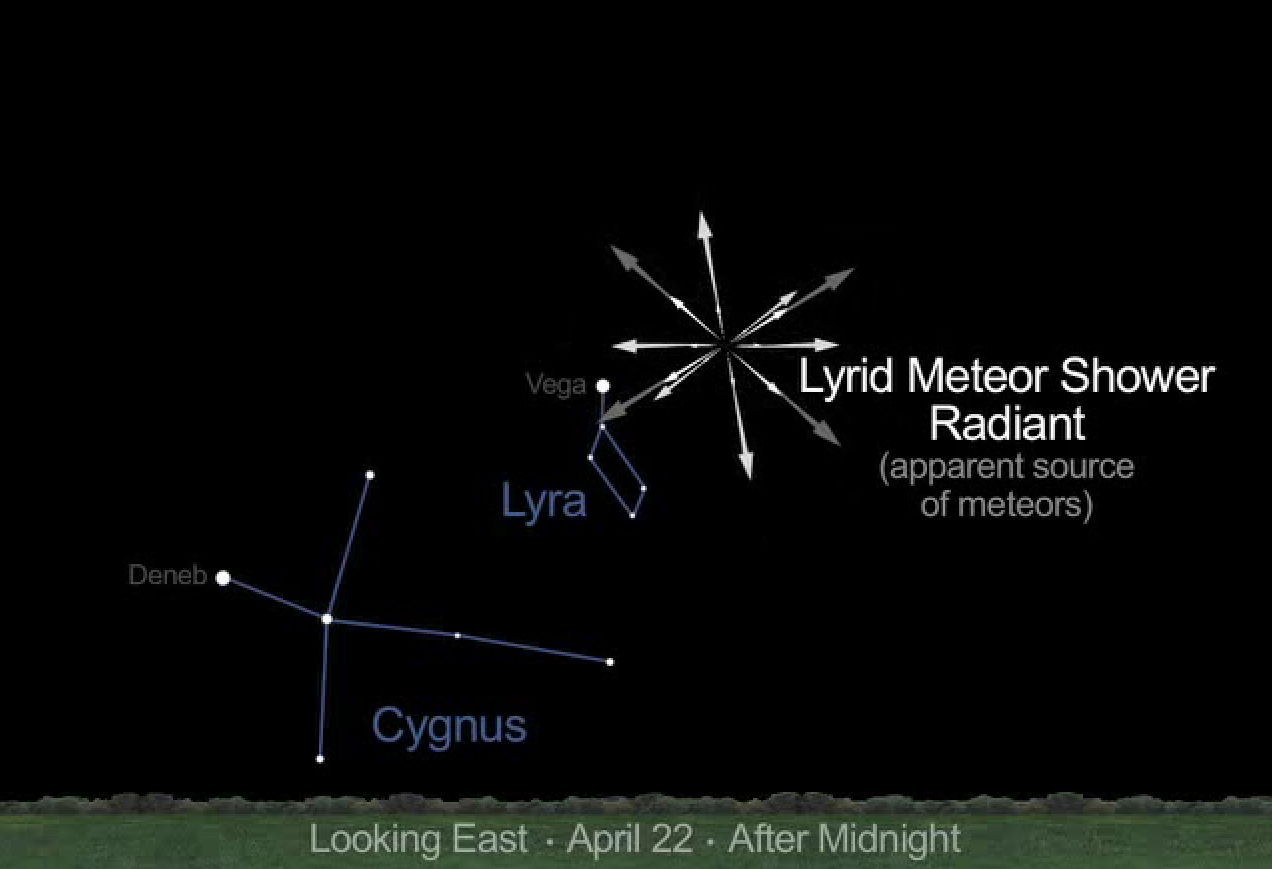Moon May Outshine Meteor Shower This Weekend

One of the "Old Faithful" meteor showers of the year will be at its best this weekend, but the moon may interfere with the celestial display.
The annual Lyrid meteor shower will peak in the eastern night sky on late Sunday and in the wee hours of Monday (April 21 and 22). The bright moon, which is in its gibbous phase, may wash out all but the brightest of the "shooting stars."
This year, the Lyrid meteor shower runs from April 16 to 25 but will be the most plentiful during the two days of their peak weekend. Weather permitting, stargazers with clear dark skies, well away from city lights, could see between 15 and 20 meteors per hour. [Amazing Lyrid meteor shower photos of 2012]
The Lyrid meteors appear to radiate out from in the small constellation Lyra (hence their name), which can be found about 7 degrees southwest (to the lower right) of the brilliant blue-white star Vega. For reference, your clenched fist held at arm's length covers roughly 10 degrees of the night sky. For the more precise stargazers, the actual radiant point of the Lyrid meteor shower is on the border between the Lyra star patter and the dimmer Hercules constellation.
Moon Muscles In
The Lyrid meteor shower is hardly a rich celestial display like those created by the August Perseid shower or December's Geminids display. But April's Lyrids have been described at times as "occasionally spectacularly bright and swift." About 20 to 25 percent of the shower's meteors tend to leave shining trails in their wake that persist for a few moments.
The orbit of the Lyrid meteors strongly resembles that of Thatcher's Comet, which swung by Earth during the spring of 1861 and has an orbital period of approximately 415 years. In 1867, astronomer Johann Gottfried Galle confirmed the link between this comet and the Lyrids. That means the meteors that you may see from this display are actually tiny particles shed by Comet Thatcher during its previous visits through the inner solar system.
Breaking space news, the latest updates on rocket launches, skywatching events and more!
Unfortunately, this year the moon is going to be a problem for prospective Lyrid meteor hunters.
On Sunday night, the moon will be in its waxing gibbous phase. Its disk will be 85 percent illuminated and already high in the southern sky as darkness falls and thus will spoil much of the overnight hours. It will likely to squelch all but the brightest Lyrid streaks.
Your best chance of seeing any will come in the half-hour between the times that bright moon sets and dawn breaks: 4 to 4:30 a.m. local daylight time on Monday morning. That's when the sky will finally provide a dark backdrop to watch for meteors, and it will also be about the time that the Lyrid radiant — where the meteors will appear to diverge — will be almost directly overhead from the southern United States, and not far off it for observers in the mid-Northern Hemisphere.
Lyrid meteor surprises
The Lyrid meteor shower is thought to be responsible for events witnessed in a number of accounts throughout ancient history. Perhaps most notable are accounts from 687 B.C. and 15 B.C. in China, and A.D. 1136 in Korea "when many stars flew from the northeast," according to descriptions.
On April 20, 1803, many townspeople in Richmond, Va., were apparently awoken by a reported fire, and were able to observe a very rich display between 1 and 3 o'clock in the morning. Those meteors "seemed to fall from every point in the heavens, in such numbers as to resemble a shower of skyrockets," according to accounts.
In 1922, an unexpected Lyrid rate of 96 meteors an hour was recorded, and on April 22, 1982, some observers in Florida and Colorado recorded rates of between 90 to 100 meteors. As British meteor expert Alastair McBeath writes in the 2013 Astronomical Calendar: "Lyrids give no clues as to when another such outburst might happen, hence the shower is always one to watch."
So if the skies are clear early Monday before sunrise, and if you're in a sporting mood, why not head outside and try to catch a few "falling stars?" Good luck!
Editor's note: If you snap an amazing photo or shoot some incredible video of the Lyrids or any other celestial object or event, and you'd like to share it for a possible story or image galleryplease send images and comments, including location information, to Managing Editor Tariq Malik at spacephotos@space.com.
Follow us @Spacedotcom, Facebook and Google+. Original article on SPACE.com.

Joe Rao is Space.com's skywatching columnist, as well as a veteran meteorologist and eclipse chaser who also serves as an instructor and guest lecturer at New York's Hayden Planetarium. He writes about astronomy for Natural History magazine, Sky & Telescope and other publications. Joe is an 8-time Emmy-nominated meteorologist who served the Putnam Valley region of New York for over 21 years. You can find him on Twitter and YouTube tracking lunar and solar eclipses, meteor showers and more. To find out Joe's latest project, visit him on Twitter.
